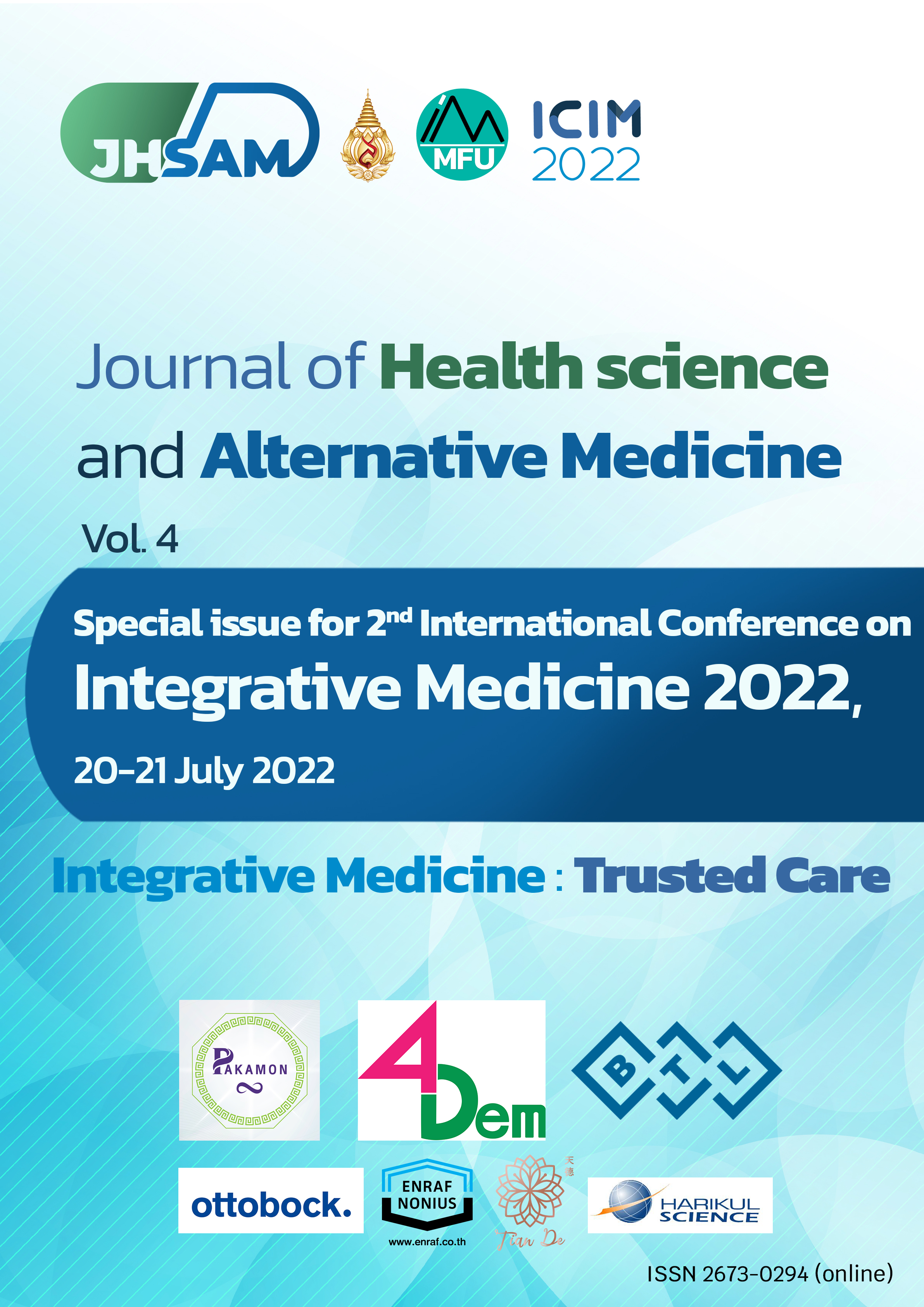C21. Metadata and the Fatty Acids Content in Thai Shrimp Paste
Main Article Content
Abstract
Introduction: The nutritional value of shrimp paste depends on the manufacturing process, such as the concentration of salt in the raw materials and the species of krill or small shrimp. In theory, different krill sources should have different bacterial species in communities. These are a major cause of the different chemical and physical properties of shrimp paste, especially the nutritional properties. This study focuses on microbial communities using the metagenome technique and the fatty acids content in the shrimp paste.
Objective: The metagenomic profiles of the bacteria and analysis of fat content in Thai shrimp paste.
Methods: Seven samples of fermented shrimp paste were obtained from various local markets and fishing villages and were analyzed for the fat content using an in-house method based on AOAC (2016). For analysis of the 16S rDNA metagenomic bacterial profile using Illumina sequencing.
Results: KK3 sample has the highest level of Saturated fatty acid and unsaturated fatty acid (Omega 3, Omega 6, Omega 9). A total of seven metagenomic samples were sequenced that report the dominant bacteria were Bacillus, Lactobacillus, Staphylococcus, and Vibrio.
Conclusion: This study can be the baseline information applied to develop the product of local or small enterprises.
Article Details

This work is licensed under a Creative Commons Attribution-NonCommercial-NoDerivatives 4.0 International License.
JHSAM publishes all articles in full open access, meaning unlimited use and reuse of articles with appropriate credit to the authors.
All our articles are published under a Creative Commons "CC-BY-NC-ND 4.0". License which permits use, distribution and reproduction in any medium,
provided that the original work is properly cited and is used for noncommercial purposes.
References
Pongsetkul, J., Benjakul, S., Sampavapol, P., Osako, K., and Faithong, N. Chemical composition and physical properties of salted shrimp paste (Kapi) produced in Thailand. International Aquatic Research. 2014; 6:155–166. https://doi.org/10.1007/s40071-014-0076-4
Daroonpunt, R., Uchino, M., Tsujii, Y., Kazami, M., Oka, D., and Tanasupawat, S. Chemical and physical properties of Thai traditional shrimp paste (Ka-pi). Journal of Applied Pharmaceutical Science. 2016;6(05):058-062.
Villagers from fishing villages, Samut songkram provinces. Interview, 11 January 2020.
Villagers from fishing villages, Chonburi provinces. Interview, 11 January 2020
อัศวิน ภัคฆวรรณ. กะปิ-บูดู เทพาฯ ผลิตภัณฑ์กลุ่มแม่บ้านเกษตรกรดีเด่นแห่งชาติ ปี 2551. เทคโนโลยีชาวบ้าน. [online] 2551:20,435. http://lib3.dss.go.th/fulltext/techno_file/CF55/CF55_A23.pdf [7/7/2022]
D'Angelo, S., Motti, M.L., and Meccariello, R. ω-3 and ω-6 Polyunsaturated Fatty Acids, Obesity and Cancer. Nutrients. 2020;12(9):2751. doi: 10.3390/nu12092751.
Shahidi, F., and Ambigaipalan, P. Omega-3 Polyunsaturated Fatty Acids and Their Health Benefits. Annual Review of Food Science and Technology. 2018;25;9:345-381. doi: 10.1146/annurev-food-111317-095850.
Gutiérrez, S., Svahn, S.L., and Johansson, M.E. Effects of Omega-3 Fatty Acids on Immune Cells. International Journal of Molecular Sciences 2019;20(20):5028. doi: 10.3390/ijms20205028
Ali, M., Kusnadi, J., Aulanni’am, A., and Yunianta, Y. Amino acids, fatty acids, and volatile compounds of terasi udang, an Indonesian shrimp paste, during fermentation. AACL Bioflux. 2020;13(2):938-950.
Pongsetkul, J., Benjakul, S., Vongkamjan, K., Sampavapol, P., and Osako, K. Microbiological and chemical changes of shrimp Acetes vulgaris during Kapi production. Journal of Food Science and Technology. 2017; 54(11):3473-3482. https://doi.org/10.1007/s13197-017-2804-4
Mantiri, R.O.S.E., Ohtsuka, S., and Sawamoto, S. Fisheries on Mesopodopsis (Mysida: Mysidae) and Acetes (Decapoda: Sergestidae) in Indonesia. Kuroshio Science. 2012;5(2):137-146
Jintana Chulek. The Economic Importance and Seasonal Variations of Acetes, Lucifer and Mesopodopsis at Tambon Khlong Khon, Samut Songkhram Province. Thai thesis database. 1997
Eusebio, P.S., Coloso, R.M., and Gapasin, R.S.J. Nutritional evaluation of mysids Mesopodopsis orientalis (Crustacea:Mysida) as live food for grouper Epinephelus fuscoguttatus larvae. Aquaculture. 2010: 306;289-294. https://doi.org/10.1016/j.aquaculture.2010.05.004
Atcha Boonme. Metagenomics: uncover the world of microbial genomes in nature. Thai Journal of Science and Technology. 2013;21(1). https://doi.org/10.1038/s41564-022-01089-w
Klindworth, A. Pruesse, E., Schweer, T., Peplies, J., Quast, C., Horn, M., and Glöckner, F.O. Evaluation of general 16Sribosomal RNA gene PCR primers for classical and next-generation sequencing-based diversity studies. Nucleic Acids Research. 2013;41: e1. doi: 10.1093/nar/gks808
Giner-Robles, L., Lazaro, B., De La Cruz, F., and Moncalian, G., FabH deletion increases DHA production in Escherichia coli expressing Pfa genes, Microb Cell Fact. 2018;17(1):88. doi: 10.1186/s12934-018-0928-5
Domenichiello, A.F., Kitson, A.P., and Bazinet, R.P., Is docosahexaenoic acid synthesis from α-linolenic acid sufficient to supply the adult brain?, Progress in Lipid Research. 2015; 59:54-66. DOI: 10.1016/j.plipres.2015.04.002
The committee and the committee work to improve the determine the nutrients that should be received daily for Thai people. DIETARY REFERENCE INTAKE FOR THAIS 2020. Nonthaburi: Bureau of Nutrition, 2020. ISBN: 978-616-11-4234-6
Simopoulos, A.P. The importance of the ratio of omega-6/omega-3 essential fatty acids. Biomedicine and Pharmacotherapy. 2002;56(8):365-79. doi: 10.1016/s0753-3322(02)00253-6

